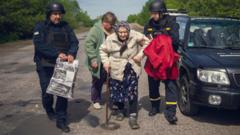In recent developments, Russian military forces have made significant territorial advancements in the northeastern Ukrainian region of Sumy, a move interpreted by local authorities as Moscow’s attempt to establish strategic "buffer zones" near the border. Oleh Hryhorov, the head of the Sumy regional administration, disclosed that Russian forces have occupied four villages and are intensifying their assaults in nearby settlements.
President Vladimir Putin last week outlined a strategy for developing "security buffer zones" along the borders of Kharkiv, Sumy, and Chernihiv regions in Ukraine, claiming it would provide "additional support" to Russian territories adjacent to Ukraine. Hryhorov reaffirmed these intentions on social media, stating that the occupied villages include Novenke, Basivka, Veselivka, and Zhuravka.
Despite these claims, official Ukrainian military sources have yet to confirm Russian control in the Sumy region. The Ukrainian military has acknowledged continued confrontations in the general area but has not pinpointed specific locations of conflict. The issue remains delicate, with military officials, including Colonel Vadym Mysnyk, revealing that Russian assaults have relied on agile units using small vehicles to avoid detection.
Widespread airstrikes and artillery bombardment have been reported in Sumy, with over 30 coordinated strikes occurring since this past weekend, targeting civilian infrastructure and causing casualties, which Russia claims are aimed solely at military sites. Local authorities are currently overseeing evacuations in over 200 settlements close to conflict zones, while military experts suggest that the advances in Sumy are part of a broader strategy to divert Ukrainian resources from more critical fronts.
The Institute for the Study of War has warned that successes in Sumy could offer Putin leverage in potential future peace negotiations, although experts agree there is no imminent threat of a Russian takeover of key urban areas. Ukrainian forces have reportedly stabilized their defenses along the border and are better prepared than at the onset of the conflict in 2022. However, the situation remains fluid, with the Kremlin capable of adjusting its strategies and troop deployments at any time.
President Vladimir Putin last week outlined a strategy for developing "security buffer zones" along the borders of Kharkiv, Sumy, and Chernihiv regions in Ukraine, claiming it would provide "additional support" to Russian territories adjacent to Ukraine. Hryhorov reaffirmed these intentions on social media, stating that the occupied villages include Novenke, Basivka, Veselivka, and Zhuravka.
Despite these claims, official Ukrainian military sources have yet to confirm Russian control in the Sumy region. The Ukrainian military has acknowledged continued confrontations in the general area but has not pinpointed specific locations of conflict. The issue remains delicate, with military officials, including Colonel Vadym Mysnyk, revealing that Russian assaults have relied on agile units using small vehicles to avoid detection.
Widespread airstrikes and artillery bombardment have been reported in Sumy, with over 30 coordinated strikes occurring since this past weekend, targeting civilian infrastructure and causing casualties, which Russia claims are aimed solely at military sites. Local authorities are currently overseeing evacuations in over 200 settlements close to conflict zones, while military experts suggest that the advances in Sumy are part of a broader strategy to divert Ukrainian resources from more critical fronts.
The Institute for the Study of War has warned that successes in Sumy could offer Putin leverage in potential future peace negotiations, although experts agree there is no imminent threat of a Russian takeover of key urban areas. Ukrainian forces have reportedly stabilized their defenses along the border and are better prepared than at the onset of the conflict in 2022. However, the situation remains fluid, with the Kremlin capable of adjusting its strategies and troop deployments at any time.
















